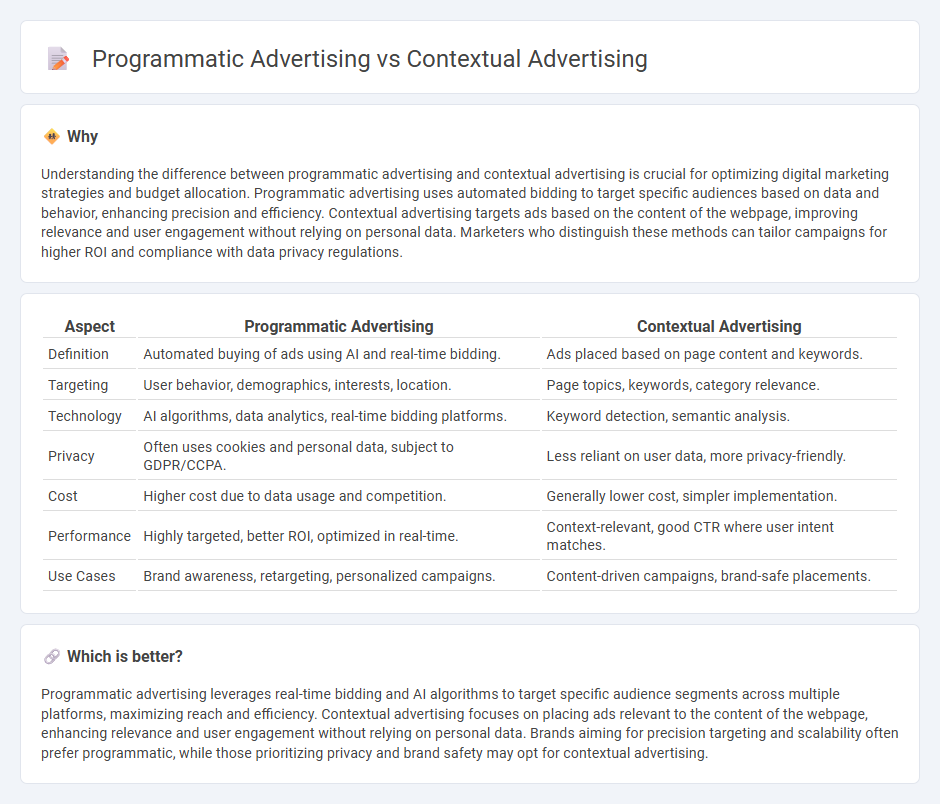
Programmatic advertising leverages automated technology and real-time bidding to target specific audiences with personalized ads across multiple digital platforms. Contextual advertising focuses on placing ads based on the content of the web page, ensuring relevance without relying on user data. Explore the key differences and benefits of programmatic and contextual advertising to enhance your marketing strategy.
Why it is important
Understanding the difference between programmatic advertising and contextual advertising is crucial for optimizing digital marketing strategies and budget allocation. Programmatic advertising uses automated bidding to target specific audiences based on data and behavior, enhancing precision and efficiency. Contextual advertising targets ads based on the content of the webpage, improving relevance and user engagement without relying on personal data. Marketers who distinguish these methods can tailor campaigns for higher ROI and compliance with data privacy regulations.
Comparison Table
| Aspect | Programmatic Advertising | Contextual Advertising |
|---|---|---|
| Definition | Automated buying of ads using AI and real-time bidding. | Ads placed based on page content and keywords. |
| Targeting | User behavior, demographics, interests, location. | Page topics, keywords, category relevance. |
| Technology | AI algorithms, data analytics, real-time bidding platforms. | Keyword detection, semantic analysis. |
| Privacy | Often uses cookies and personal data, subject to GDPR/CCPA. | Less reliant on user data, more privacy-friendly. |
| Cost | Higher cost due to data usage and competition. | Generally lower cost, simpler implementation. |
| Performance | Highly targeted, better ROI, optimized in real-time. | Context-relevant, good CTR where user intent matches. |
| Use Cases | Brand awareness, retargeting, personalized campaigns. | Content-driven campaigns, brand-safe placements. |
Which is better?
Programmatic advertising leverages real-time bidding and AI algorithms to target specific audience segments across multiple platforms, maximizing reach and efficiency. Contextual advertising focuses on placing ads relevant to the content of the webpage, enhancing relevance and user engagement without relying on personal data. Brands aiming for precision targeting and scalability often prefer programmatic, while those prioritizing privacy and brand safety may opt for contextual advertising.
Connection
Programmatic advertising leverages automated technology to buy and optimize ad inventory in real-time, often utilizing contextual advertising to target audiences based on the content they are viewing. Contextual advertising enhances programmatic campaigns by aligning ads with relevant webpage topics, improving engagement rates and ad relevance. Both strategies rely on data-driven algorithms to maximize precision and ROI in digital marketing efforts.
Key Terms
Targeting
Contextual advertising targets audiences based on the content they are currently viewing, ensuring relevance by matching ad keywords to webpage themes. Programmatic advertising uses automated algorithms and real-time bidding to target users based on behavioral data, demographics, and intent across multiple channels. Explore the advantages and best practices of both targeting methods to optimize your ad campaigns.
Automation
Contextual advertising targets ads based on the content of a webpage, leveraging keyword analysis and page context to deliver relevant messages, while programmatic advertising automates the purchasing process using AI-driven algorithms and real-time bidding across multiple platforms. Automation in programmatic advertising enhances efficiency, optimizing ad placements and audience targeting through data integration and machine learning, whereas contextual advertising relies more on manual or predefined contextual rules. Discover how automation is transforming ad strategies and maximizing ROI in digital marketing.
Real-time bidding
Real-time bidding (RTB) is a core component of programmatic advertising, allowing advertisers to bid on individual ad impressions in real-time through automated auctions. Contextual advertising targets users based on the content of the webpage rather than user data, relying on keyword analysis and page context instead of auction-based buying. Explore how RTB optimizes ad spend and enhances targeting precision by diving deeper into programmatic advertising techniques.
Source and External Links
What is Contextual Advertising & Why It Matters - TEGNA - Contextual advertising delivers relevant ads based on the content users are viewing, leveraging content categories or keywords to target audience demographics and buying intent while ensuring brand safety and complementing broader TV campaigns.
What is Contextual Advertising? Why is it Important? - Amazon Ads - Contextual advertising uses content analysis and keyword matching to place ads aligned with the webpage's subject, enhancing engagement without relying on user data by using AI and machine learning for precise, privacy-friendly targeting.
What You Need to Know About Contextual Advertising - DoubleVerify - Contextual advertising focuses on placing ads relevant to the content rather than individual user behavior, making ads more relevant and privacy-friendly by targeting based solely on the surrounding webpage content.
 dowidth.com
dowidth.com